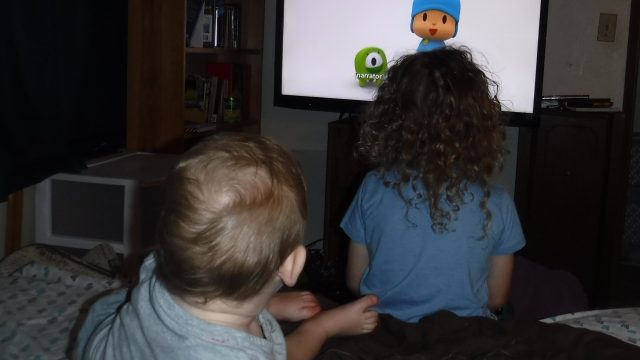Today . . . on a very special Afterschool Special . . . .
We initially discovered Pocoyo on YouTube, where you’d be just as likely to find the original Spanish version as the English-language dub. Which is voiced by Stephen Fry because why not. Since my son Simon was two when we first encountered it and since we do want the kids to be bilingual if we can manage it, we went ahead with that. Spanish? Sure, why not. It’s a simple enough show that the plot can be figured out from watching and not listening anyway.
Pocoyo is a small child wearing a blue outfit featuring a zipper tab at his neck and a hat with floppy ear covers. His friends include Pato the Duck and Elly the Elephant and Loula the Dog. I’ll admit I think of Pocoyo as male, but he’s really of indeterminate gender. Nothing about him is gender relevant. He is a child of few words; most of the talking is the narrator, who asks Pocoyo and the others questions and interacts with a small crowd of invisible children who also answer questions.
What fascinates me about the show is that the characters live and play in the eponymous featureless white void. In one episode, we see a character’s bedroom. There’s furniture, and there are posters hanging on nothingness—and two of the other characters run back and forth through the nothingness on which the posters are hanging. When they go to other planets—did I mention they sometimes go to other planets?—there appears to be a surface of those planets, and space is black. When they go undersea to visit Whale—yup, they go undersea to visit Whale a few times—there’s definitely water and the ocean floor and similar. And Sleepy Bird lives in a tree that’s there when Sleepy Bird is and not when not, and things like that. But in general, the only thing onscreen is the characters and whatever they’re directly interacting with.
I suppose it is arguably because that’s all we need. When we are focusing on how Pocoyo is a lousy doll-sitter for Elly’s doll, all we need is Pocoyo, Elly, and the doll. In theory, backgrounds—and foregrounds—might be distracting from the narrative, such as it is? After all, this cartoon is for small children. My daughter Irene will fixate on it every now and again, albeit not for very long. She’s fascinated by the images, which are certainly more distinct when it’s bright pink elephant (sure, why not?) on a white background.
Honestly, though, what I like about Pocoyo is that there’s nothing really bad about it. Elly is interested in being a princess sometimes, and she dances, but she’s also a weight lifter and she rides on a scooter. When one of the characters does something to upset the others, the narrator talks to them about what’s wrong with it. “Pato, the others are upset with you because you insist that they have to do what you want, and they don’t want to.” “Pocoyo, the others are upset with you because you keep taking their stuff without asking.” “Elly, the others are upset with you because they want to dance, too.”
And unlike some shows my kids watch, there isn’t an implication that everyone is equally to blame in a disagreement. The character in question is doing something that bothers the others, and they’re right to be annoyed. Now, all the characters at one time or another does something that bothers the others. Or at least all the characters that are really shown as people; in the main grouping, Pocoyo and Elly and Pato are people and Loula is basically a dog. Sleepy Bird, Baby Bird, Caterpillar, and Butterfuly are minor characters who are sometimes shown as having enough personality to affect the plot but not always. Also, there are aliens. Because okay.
Pocoyo doesn’t always seem interested in making sense, but it’s entertaining enough. Educational inasmuch as it tries to have a plot at all. Fred the Octopus, who speaks in gibberish and only has four legs? Sure, why not? The narrator who isn’t seen as omniscient at all but basically just another adult. A particularly friendly one, but one who is himself sometimes wrong, even if he is Stephen Fry. I admit that we started watching this show as much as we did not because I like it but because I don’t dislike it, but in children’s television, that’s something.
Help keep our Netflix subscription going; consider supporting my Patreon!


